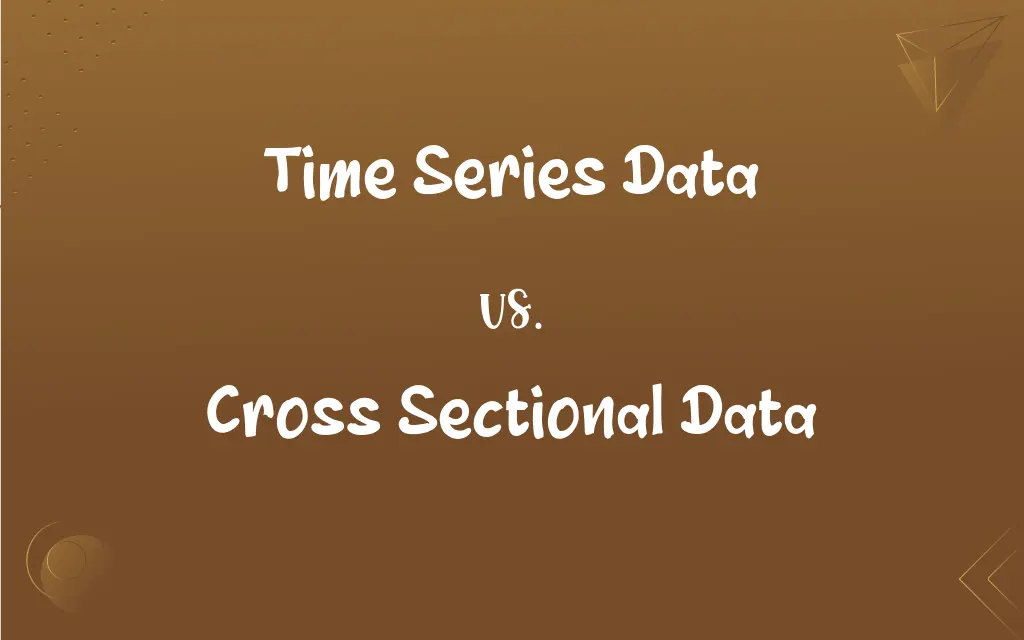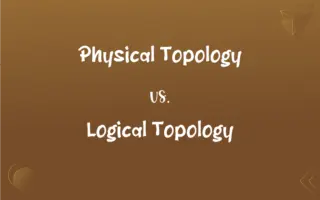Time Series Data vs. Cross Sectional Data: What's the Difference?
Edited by Aimie Carlson || By Harlon Moss || Published on March 25, 2024
Time series data is a sequence of data points collected over time intervals, whereas cross-sectional data is collected from multiple subjects at a single point in time.

Key Differences
Time series data refers to data collected at regular intervals over a period. It emphasizes the temporal sequence of data points, making it ideal for trend analysis and forecasting. For instance, daily stock prices over a year form a time series. Cross-sectional data, conversely, captures a snapshot of varying subjects at a single point in time. This type of data is used to compare different subjects or groups at a specific moment, like a survey conducted among different age groups at one time.
Time series data is inherently chronological, meaning each data point is dependent on its position in the time sequence. This characteristic is crucial for understanding patterns like seasonality or cyclical trends. For example, monthly unemployment rates over several years depict a time series. Cross-sectional data lacks this temporal dimension, focusing instead on the variation among subjects at one time. It's like taking a 'cross-section' of a population, as in a study comparing income levels across different cities at the same time.
Time series data is valuable in fields where understanding evolution over time is crucial, like economics or meteorology. Analyzing such data can reveal long-term trends and help in making future predictions. Cross-sectional data, however, is useful for studies that require a broad comparison at one time point, like sociology or market research. It provides a snapshot that helps in understanding the current state or characteristics of different groups.
In time series data, the main challenge is dealing with elements like trends, seasonality, and autocorrelation (where current values are correlated with past values). Handling these factors is essential for accurate analysis and forecasting. Cross-sectional data, in contrast, often deals with challenges like ensuring a representative sample and controlling for variables that might skew comparisons across different groups or subjects.
Time series data often requires sophisticated statistical methods to model and predict future data points, considering the time-based dependencies in the data. Techniques like ARIMA (AutoRegressive Integrated Moving Average) are common. Cross-sectional data typically employs different statistical techniques, such as regression models, to understand the relationships and differences between the subjects or groups at the time of the study.
ADVERTISEMENT
Comparison Chart
Temporal Dimension
Collected over time
Collected at one time point
Focus
Trends and changes over time
Variations among subjects at one time
Application
Trend analysis, forecasting
Comparative analysis, current state assessment
Analysis Challenges
Trends, seasonality, autocorrelation
Representative sampling, variable control
Statistical Methods
ARIMA, time series analysis
Regression models, variance analysis
ADVERTISEMENT
Time Series Data and Cross Sectional Data Definitions
Time Series Data
Data points collected sequentially over time.
Monthly rainfall measurements over the past decade form time series data.
Cross Sectional Data
Data used to analyze the current state of various subjects.
Cross sectional data from a health survey reveals current public health trends.
Time Series Data
Sequential data used for forecasting future values.
Temperature records over years are time series data used for climate modeling.
Cross Sectional Data
Non-chronological data for comparative analysis.
Comparing educational qualifications of people in different professions using cross sectional data.
Time Series Data
Chronologically ordered data, typically with equal intervals.
Daily stock market closing prices are an example of time series data.
Cross Sectional Data
Data collected from multiple subjects at a single time point.
A survey of voter preferences taken on a single day is cross sectional data.
Time Series Data
Data where each point is dependent on previous points in time.
Weekly sales figures in a store represent time series data for analysis.
Cross Sectional Data
Snapshot data comparing different subjects or groups.
Income levels across different cities, measured simultaneously, are cross sectional data.
Time Series Data
Data that allows analysis of trends and patterns over time.
Time series data of annual GDP growth shows economic trends.
Cross Sectional Data
Data focusing on variation among groups at one point.
Analyzing car ownership across age groups at a single time provides cross sectional data.
FAQs
What is an example of time series data?
Daily temperature readings over a year.
Can you give an example of cross-sectional data?
A survey of consumer preferences conducted across different age groups at the same time.
What is time series data?
Data collected in a sequence over time intervals.
Why is time series data important in forecasting?
It helps in identifying trends and making predictions based on historical patterns.
What makes cross-sectional data useful for comparative studies?
It allows for comparison among different groups or variables at a single moment.
What statistical techniques are used for cross-sectional data?
Techniques like regression analysis and variance analysis.
Is cross-sectional data limited in showing time-related changes?
Yes, it cannot effectively reveal changes over time as it's a one-time snapshot.
How is cross-sectional data used in sociology?
It's used to compare different social groups or phenomena at a specific point in time.
How does cross-sectional data differ from time series data?
Cross-sectional data is collected from various subjects at a single point in time.
How do you analyze time series data?
Using methods like ARIMA that account for trends, seasonality, and time dependencies.
What is a key challenge in analyzing cross-sectional data?
Ensuring that the sample is representative of the broader population.
Can time series data reveal seasonal patterns?
Yes, it's particularly effective in identifying and analyzing seasonal trends.
Can time series data be used to predict future events?
Yes, it's commonly used for predictive modeling in various fields.
What industries benefit from time series data analysis?
Finance, meteorology, economics, and more.
Are there any specific challenges in analyzing time series data?
Yes, dealing with autocorrelation, trends, and seasonality are key challenges.
What's the significance of interval regularity in time series data?
Regular intervals ensure consistency and reliability in trend analysis.
Is cross-sectional data effective in longitudinal studies?
No, as it provides information from only one time point.
How does cross-sectional data contribute to market research?
It helps in understanding the current state of the market and consumer behavior.
How does sample size affect cross-sectional data analysis?
Larger, more diverse samples can lead to more accurate and generalizable findings.
Can time series data be used in economics?
Yes, it's widely used for economic trend analysis and forecasting.
About Author
Written by
Harlon MossHarlon is a seasoned quality moderator and accomplished content writer for Difference Wiki. An alumnus of the prestigious University of California, he earned his degree in Computer Science. Leveraging his academic background, Harlon brings a meticulous and informed perspective to his work, ensuring content accuracy and excellence.
Edited by
Aimie CarlsonAimie Carlson, holding a master's degree in English literature, is a fervent English language enthusiast. She lends her writing talents to Difference Wiki, a prominent website that specializes in comparisons, offering readers insightful analyses that both captivate and inform.
































































